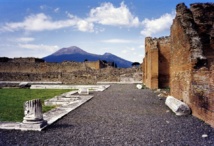
Image by Morn the Gorn; accessed via Wikipedia.
Although the disaster has been exhaustively examined, "Life and death in Pompeii and Herculaneum" seeks to shed fresh light on the daily lives of those killed that day.
It brings together objects from both destroyed cities which display a startling similarity to those we use today, from the colander and bakeware in the kitchen to dice used in games.
One of the most evocative images is a crib which was burned to charcoal when volcanic material measuring 400 degrees Celsius swept through Herculaneum. The infant in it was incinerated.
"The Romans had rooms in homes filled with things just like we have. They had a consumer lifestyle, they liked nice things," curator Paul Roberts told AFP.
"It's really a way of bringing the Romans closer to us. They're not just 'I, Claudius', they're not gladiators -- they're us."
Visitors to the exhibition are taken through rooms in a Roman house, decorated with frescos including one embellished with graffiti animals, likely the work of younger members of the family.
There are countless examples of everyday life, from furniture to jewellery and sculptures, as well as erotic art that would have been displayed with little embarrassment.
But this image of two bustling cities -- Pompeii the industrial hub of the region and Herculaneum a smaller seaside city -- is brought to a abrupt and brutal halt, just as they were.
At the end of the exhibition are casts of a man who died as he crouched down behind a wall desperately seeking protection, and of a family flung back in agony by waves of ash and volcanic rock in Pompeii.
Such was the heat that hit Herculaneum that most people were incinerated immediately, but in Pompeii it was slightly cooler, allowing lava to harden around the bodies of the dead.
In the 18th century, archaeologists discovered the voids where these bodies had been and filled them with plaster, creating casts that show in gruesome detail how the people died.
Many strike 'the boxer pose', their arms held up as if to throw a punch. It is caused by the heat which contracts the tendons.
After half an hour examining the lives of ordinary Romans at the museum, this graphic evidence of one family's demise is shocking.
The mother is holding her toddler child on her lap as she falls back against the wave of heat, her husband next to her, his body contorted. Another child lies lifeless on the floor nearby.
"People didn't see it coming," said Vanessa Baldwin, assistant curator of the exhibition. "They were living their daily lives when it hit."
"Life and death in Pompeii and Herculaneum" runs from March 28 to September 29 at the British Museum.
---------------------------------------------------------------------------------------------------------------------
It brings together objects from both destroyed cities which display a startling similarity to those we use today, from the colander and bakeware in the kitchen to dice used in games.
One of the most evocative images is a crib which was burned to charcoal when volcanic material measuring 400 degrees Celsius swept through Herculaneum. The infant in it was incinerated.
"The Romans had rooms in homes filled with things just like we have. They had a consumer lifestyle, they liked nice things," curator Paul Roberts told AFP.
"It's really a way of bringing the Romans closer to us. They're not just 'I, Claudius', they're not gladiators -- they're us."
Visitors to the exhibition are taken through rooms in a Roman house, decorated with frescos including one embellished with graffiti animals, likely the work of younger members of the family.
There are countless examples of everyday life, from furniture to jewellery and sculptures, as well as erotic art that would have been displayed with little embarrassment.
But this image of two bustling cities -- Pompeii the industrial hub of the region and Herculaneum a smaller seaside city -- is brought to a abrupt and brutal halt, just as they were.
At the end of the exhibition are casts of a man who died as he crouched down behind a wall desperately seeking protection, and of a family flung back in agony by waves of ash and volcanic rock in Pompeii.
Such was the heat that hit Herculaneum that most people were incinerated immediately, but in Pompeii it was slightly cooler, allowing lava to harden around the bodies of the dead.
In the 18th century, archaeologists discovered the voids where these bodies had been and filled them with plaster, creating casts that show in gruesome detail how the people died.
Many strike 'the boxer pose', their arms held up as if to throw a punch. It is caused by the heat which contracts the tendons.
After half an hour examining the lives of ordinary Romans at the museum, this graphic evidence of one family's demise is shocking.
The mother is holding her toddler child on her lap as she falls back against the wave of heat, her husband next to her, his body contorted. Another child lies lifeless on the floor nearby.
"People didn't see it coming," said Vanessa Baldwin, assistant curator of the exhibition. "They were living their daily lives when it hit."
"Life and death in Pompeii and Herculaneum" runs from March 28 to September 29 at the British Museum.
---------------------------------------------------------------------------------------------------------------------









 Home
Home Politics
Politics









